Ok so I'm really new to electrical engineering and I was wondering if someone could help me analyze this circuit using KVL and KCL node analysis. I'm not really sure as to how I can set the KVL and KCL equations up and how I can calculate the Thevenin resistance. Can someone give me some pointers or help me set up my solution?
-
1Can you add the steps you have already done into the question. For example, you can label the nodes you have identified and the mark the assumed current directions and name them. – AJN Aug 07 '20 at 16:41
-
Between A1 and A2 it's R3 + R4||(R2+R1) - can you see why? You need to show why because that's all the help you can expect for homework on this site. – Andy aka Aug 07 '20 at 16:42
-
1You should word your question titles so that they are helpful for future visitors as well as those who might provide answers. Also you've [posted before with a crappy title](https://electronics.stackexchange.com/q/515163/2028) and never improved it. Show some concern about the community you wish to gain information from. – JYelton Aug 07 '20 at 17:49
-
1@John I just saw this. I remember you from an earlier question. I provided KCL equations for that answer and found, I think, that their production was beyond your ken. That's not a bad thing. But it means that you need to hold short of these kinds of problems until you can master "mesh" and "nodal" and, before that yet, Thevenin and Norton equivalents. I get it that you are putting in lots of time (good) and that you are pushing yourself with problems. But given what you failed to follow so far, perhaps you need to back up a bit and then push forward after picking up a few tools. Am I wrong? – jonk Aug 07 '20 at 18:50
-
@jonk so I already understand the basic stuff like series/parallel and ohms law and stuff like that, including the mathematics behind them. What I don't understand is trying to figure out how to get the Thevenin resistance and setting up the solution that way. I understand the "black box approach" of shorting out the wires and opening the circuit but I dont understand where the equations are coming from, which is what I want someone to help me understand – John Aug 07 '20 at 18:55
-
1@John I get all that. (The basic idea of a black box isn't hard to grasp.) But perhaps the most telling thing to me that you wrote in that earlier question was this idea: *"I'm using Ohm's law and dividing 5 by their respective resistances to find the currents correct?"* Here, you were using a tool you know of (finding a branch current through a series of resistors) to approach a more complex problem which couldn't be approached that way. These holes need to be filled before hitting a problem like this. Mesh and nodal are needed. Simultaneous linear equations are needed. Norton & Thevenin too. – jonk Aug 07 '20 at 19:00
-
1@John You should push yourself. I don't want to suggest taking any of that away from you. But sometimes being over-eager and imagining more than you are capable of by wading into the deeper end of the pool just leads to forcing others to rescue you all the time from yourself. There's a time when you need to recognize you need to go back a bit and take a class with the "young kids at the shallow end of the pool" before again trying to dive into the deep end. Is there a simpler problem, somewhat complex to you, where you could correctly set up a single nodal or mesh equation? Just one case? – jonk Aug 07 '20 at 19:04
-
I removed my downvote. Thanks for improving the question title. – JYelton Aug 07 '20 at 19:21
-
I think this is homework from MITx circuits and electronics series on edx ? because if it is, it is not allowed to be posted like this. Just post your inquiry, not the problem itself. if this is from circuits and electronics repeat the videos to get a better understanding and use a tool called circuits sandbox to simulate your circuits. – Mohamed Atef Aug 07 '20 at 16:34
2 Answers
One way to calculate the thevenin equivalent circuits is to just find the voltages and currents in the circuit. And then solve for the voltages and currents when you short A1, to A2 or short B1 to B2.
KCL just says that the sum of the current in each node is 0.
You have five nodes. A1, A2, B1, B2 and an un-named one connected to V1, I1, R1.
So take each node and write an equation for the current. You can choose whether current flowing into the node is positive or negative, but you must make the same choice for all branches.
You then solve the set of five equations for either voltage or current. You can do this either through substitution, or matrix methods.
As a hint, the current flowing through a branch that has a current source, is equal to the value of the current source. The voltage flowing between two nodes that have a resistor between them is the voltage difference divided by the resistance.
- 11,816
- 17
- 30
-
-
-
To find the Thevenin equivalent for nodes B1, B2 you need to find the voltages at nodes B1 and B2. The Thevenin voltage source value (V) is the voltage between B1, B2. The thevenin resistance (R) can then be found by solving the circuit with B1, B2 shorted and finding the current (I) through the short. The resistance R is then V / I. – user4574 Aug 07 '20 at 16:47
-
@user4574 can u point me to the equations I would need to set up to get the Thevenin resistance? Or just show me how I would do this problem. I'm sorry for making it sound like I want you to do the work for me, I'm just really confused about how to do this mathematically speaking. – John Aug 07 '20 at 17:33
-
I commented above on how to find the Thevenin voltage and resistance if you knew the voltages and currents at each node. But to find that you first need to write a set of equations. One for each node so that you can solve for the voltages and currents. As a hint I will give you the equation for B2. Node B2 has three branches going into it. One through R2, one through R4, and one through R3. Note that the current in R3 is equal to I2. So the equation for node B2 is... (B1 - B2) / R2 + I2 + (0 - B2)/R4 = 0. – user4574 Aug 07 '20 at 17:48
I'm not really sure as to how I can set the KVL and KCL equations up and how I can calculate the Thevenin resistance. Can someone give me some pointers or help me set up my solution?
Open-circuit the current sources and short-circuit the voltage sources to find equivalent Thevenin resistance: -
Hence, impedance between A1 and A2 is: -
$$R_3 + R_4||(R_2 + R_1)$$
Can you take it from here and put numbers into the formula then do the same for the impedance between B1 and B2?
Knowing V1, I1 and I2 is not needed for this so don't waste your time pursuing that path. Voltages and currents stated are red-herrings.
- 434,556
- 28
- 351
- 777
-
yessir. so this would be 3.3 + (1/((1/4.7) +(1/19.2))) which would be 7.0757 equivalent resistance. Is this correct? – John Aug 07 '20 at 18:24
-
You don't really need me to do calculator work for you do you? I told you how to do it. How to use a calculator is not a relevant question on this site. – Andy aka Aug 07 '20 at 18:31
-
Nope I think I understand the calculations perfectly. Is (2+1)||(3+4) the impedance between B1 and B2 or am I doing something wrong there? – John Aug 07 '20 at 18:42
-
Nowhere close to being right. Just get a pen and paper and draw out what you see and ask yourself what R3 has to do with any of it. Use your eyes! – Andy aka Aug 07 '20 at 18:55
-
so i thought about it and I have changed my view of this, now it just looks like a series to me so R1+R2+R4 – John Aug 07 '20 at 19:01
-
Incorrect. Try again. Use your eyes - draw it out on paper. One more chance then I'm ignoring you. – Andy aka Aug 07 '20 at 19:03
-
wait one more thing, when you say open, the implies that there is no connection there correct, and short is implying that we just replaced the voltage source with a wire? – John Aug 07 '20 at 19:05
-
Jeez, I drew a picture and put it in my answer. What does the picture tell you? Don't answer because you have only one more answer. – Andy aka Aug 07 '20 at 19:20
-
4||(2+1) is my final guess. tbh I dont even know if electrical engineering is for me anymore. I think I should just stick with programming cus im actually good at that ;( – John Aug 07 '20 at 19:33

